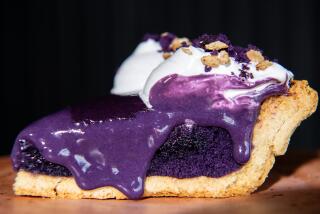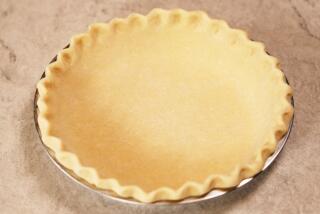Turning Dough For Right Crust
- Share via
Last week’s Back to Basics column covered the beginning steps in making pie crust--cutting the shortening into flour combined with salt, adding water and forming the pastry into a ball. The pastry was then ready to be rolled out or chilled from 30 minutes to two days.
Some sources claim that chilling tenderizes the dough, makes it easier to handle and helps minimize shrinkage during baking; others feel it makes little difference. Dough that has been refrigerated for an extended period, however, should be removed about an hour before being shaped so it reaches room temperature.
We recommend using a pastry cloth on a smooth surface and stockinette (or stocking) cover over a revolving rolling pin. A board, marble slab or Formica countertop and other types of rolling pins may be used, however, if preferred. Working quickly in a cool area will aid in keeping the pastry dough tender and flaky.
A Little Flour
Lightly flour both the work surface and rolling pin, rubbing well into both so the flour keeps the pastry from sticking but does not get incorporated and toughen the dough. Flatten the dough ball into a round, thick disk without cracks in the sides (Photo 1).
Lightly roll the dough from the center out in all directions, with short, smooth strokes (Photo 2). Try to keep the pastry round, without any ragged edges. Repair breaks in the edge by pressing the dough together with your fingertips. Lift and rotate the dough periodically to keep it from sticking to the surface.
The goal is to roll the pastry into a circle about two inches larger in diameter than the inverted pie plate it will fill and one-eighth-inch thick. When rolled thin enough, only a slight imprint will remain when the dough is touched lightly with a finger.
Transfer the Dough
To transfer the dough into the pie plate, lightly roll it around the rolling pin, then unroll over the pie plate (Photo 3). Center the pastry and gently ease it into the pan, being careful not to stretch the pastry or it will shrink during baking.
Press the pastry against the pie plate with your fingers to remove any air pockets. Trim the pastry hanging over the edge of the pie plate with scissors (Photo 4) or a sharp knife, leaving about an inch to fold under and flute.
Any tears may be repaired by pressing the dough together with your fingertips or patching with trimmings. Future Back to Basics columns will be devoted to methods of fluting the edges and making double-crust and lattice-topped pies.
Address questions on food preparation to You Asked About . . . , Food Section, The Times, Times Mirror Square, Los Angeles 90053. Personal replies cannot be given.


